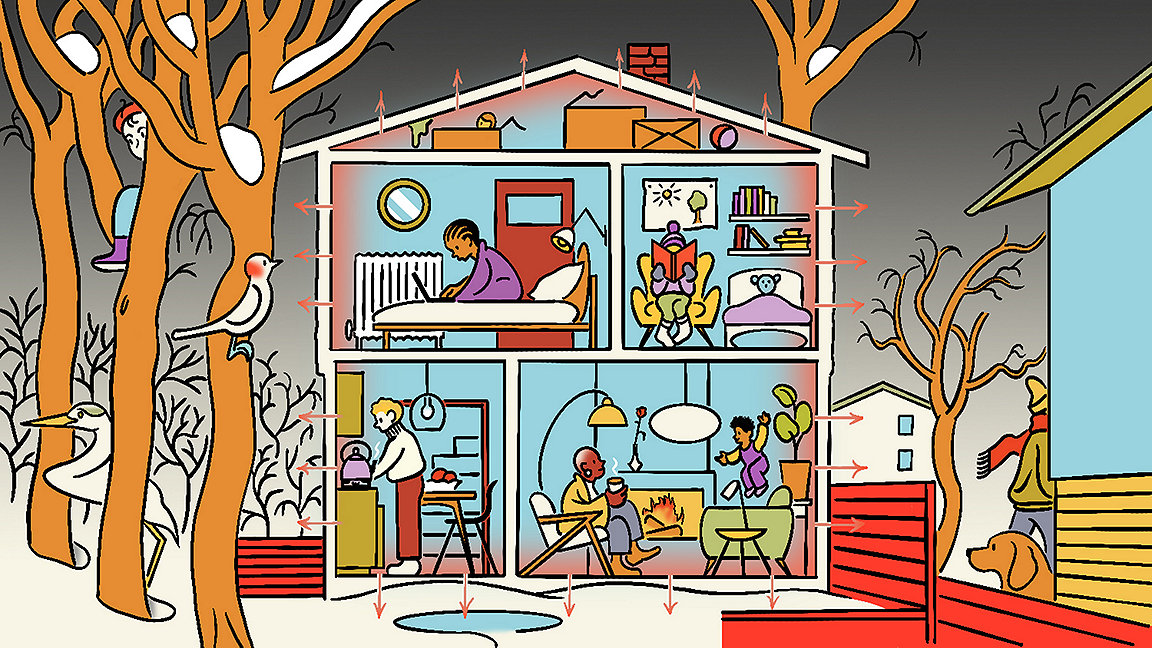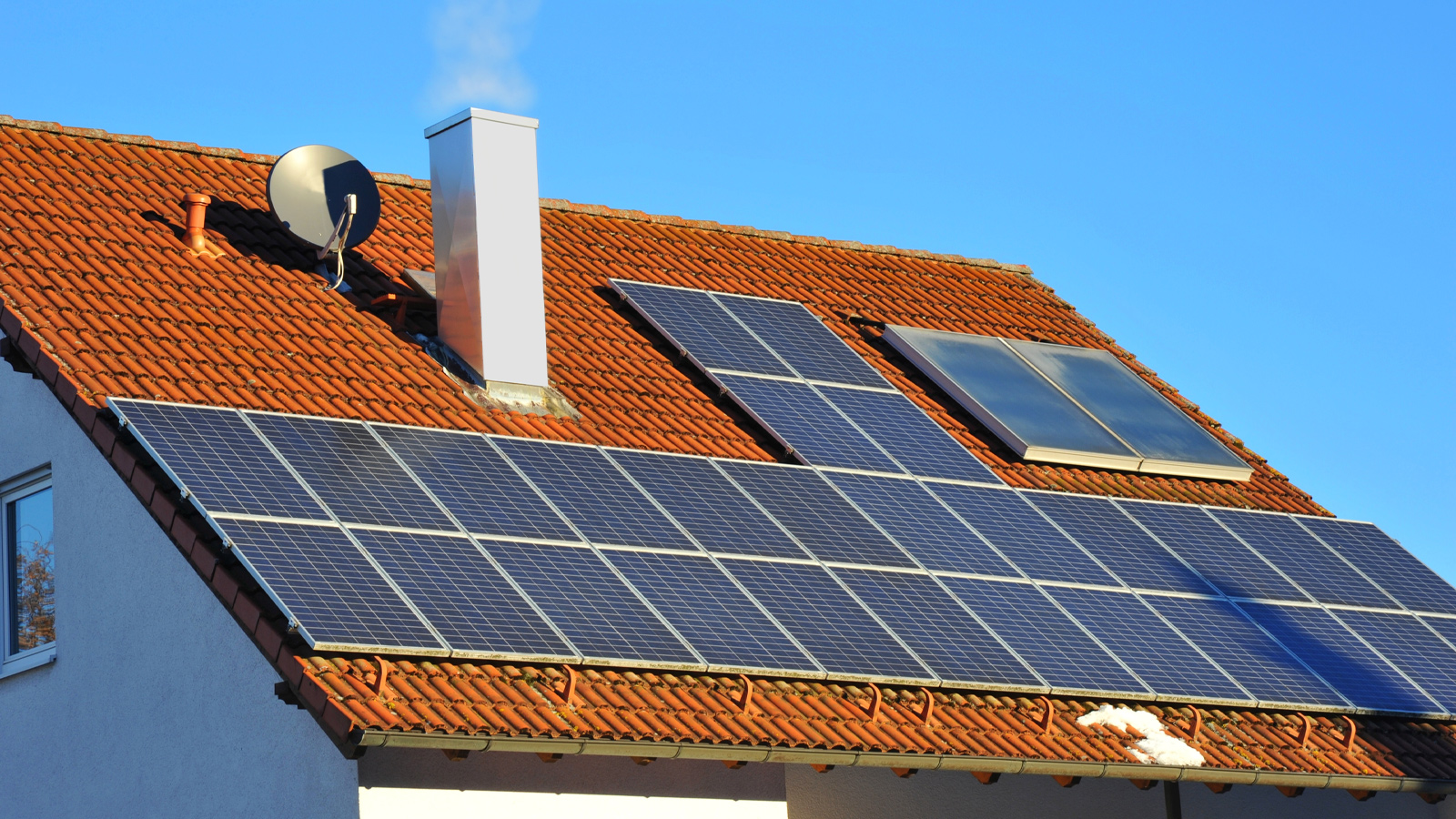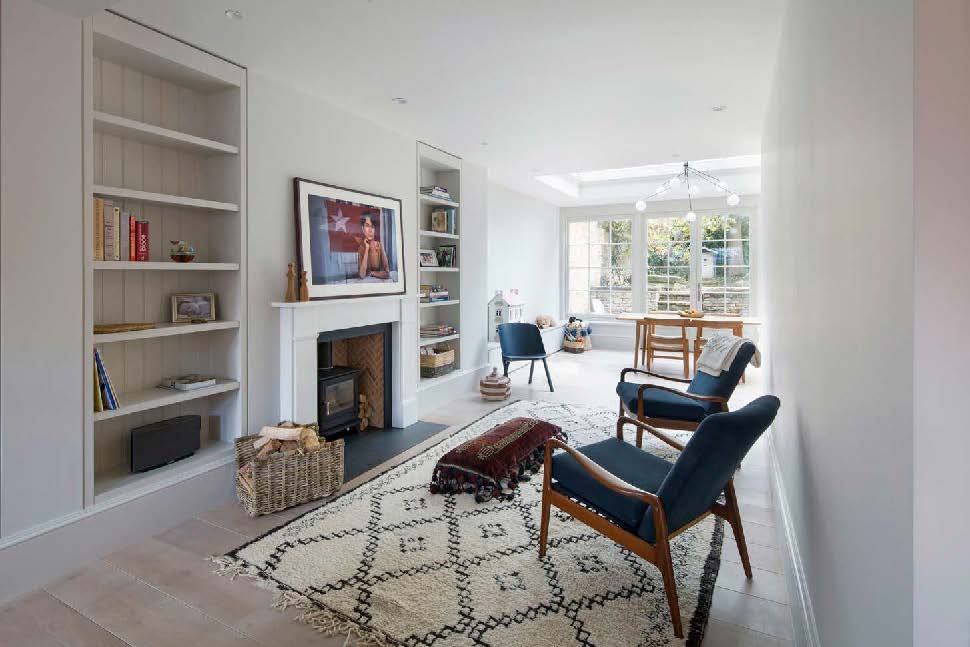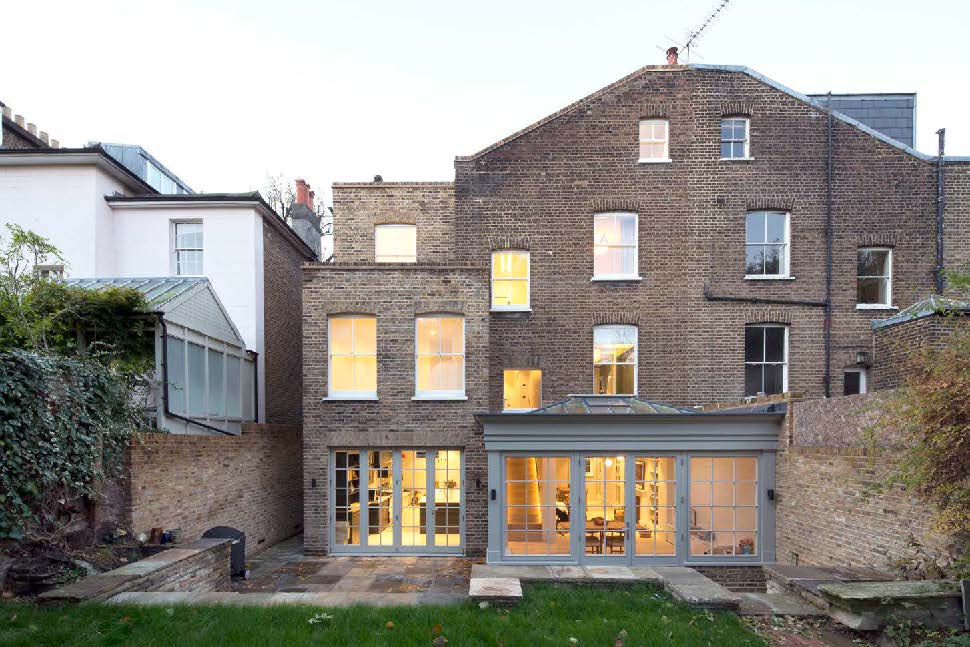
Illustration: Masha Krasnova-Shabaevaon
Buildings are bad for the planet, and old buildings are worse. In the EU, for example, buildings account for around 40% of energy consumption, and more than one-third of emissions. That’s no surprise, given that more than 35% of the continent’s building stock is at least 50 years old, and much of that built before 1945 is largely uninsulated.
However, around the world, energy-efficient renovation is rare. In Europe, where the target is to become climate-neutral by 2050, only 1% of buildings undergo such retrofitting each year.
Effective action is vital to reduce energy consumption, and housing has a crucial role to play. In the UK alone, there are 29 million existing homes that need to become low-carbon and resilient to climate change, according to the country’s Committee on Climate Change (CCC).
Living in hot houses
In much of the cool north, this is a relatively recent problem. Central heating only became commonplace in the 1970s and 1980s. “Our homes are now hotter than at any point in history,” says Louis Platman, curatorial assistant at London’s Museum of the Home, “and, while this may allow us to wear next-to-nothing while a blizzard rages outside, it comes with a considerable environmental cost.”
Our comfort is the planet’s downfall. But efforts are being made to develop long-term decarbonisation strategies for buildings. The European Commission wants to speed up building renovation, and in October 2020 published a “renovation wave” strategy to boost home renovations. Part of the European Green Deal, it aims to double annual energy renovation rates over the next 10 years.
The question for all nations is how to deliver such a transformation because, despite the urgency, there are significant barriers to retrofitting existing homes. These include cost, disruption, lack of awareness, feasibility issues and a shortage of appropriate skills.

Support and incentives
In terms of cost, there is some support out there for homeowners and landlords, much of it in the form of tax incentives and subsidies. The UK has the Build Back Better initiative, and the more recent Green Home Grant, in which people in England can get up to £5,000 towards the cost of energy saving measures such as insulation, new heating systems, solar panels and draft-proofing.
Phillipa Grant is director of energy and sustainable development at consultant AESG in Dubai. She sees the benefits of such schemes, as long as there is public awareness of them. “They can help to incentivise individuals by relieving the initial financial burden and shortening the payback period for works done.” But first, homeowners must be made aware of their options. Private companies and technology providers have a role to play here, Grant adds, by giving “comprehensive advice and solutions”
One scheme that is giving such comprehensive advice is Solutions4Renovation, an initiative launched in France, Spain and Ireland by the Turnkey Retrofit consortium with backing from the European Commission. Designed to be a "one-stop-shop" for homeowners, the service offers tailor-made solutions and guidance, transforming what can be complex and fragmented it into a simple, straightforward and attractive process.
Mat Lown MRICS, partner and head of sustainability at TFT, believes governments could help in other ways. He suggests reducing the VAT payable on energy efficiency improvements. “The housing benefit system could be another avenue to encourage retrofitting which would contribute greatly to those who need it.”
And what if people now working from home could be incentivised? Lown wonders whether their corporate allowances could be directed away from IT equipment and ergonomic chairs towards “the comfort and economy of a well-performing home heating system”.
What about that gap in skills and training in providing insulation, window upgrades, boiler servicing and electrifying homes? There are new roles emerging in the drive towards a low-carbon economy, as well as an existing skills gap in the building sector that needs plugging. “Local authorities could support this by raising awareness of jobs, providing grants and supporting the best contractors,” says Lown. However, with COVID-19 having had a financial impact on local authorities, many of which were already struggling, it’s doubtful whether this will be high on their list of priorities.
The physical factor
However, Grant cautions that “the many nuances of our existing housing stock present physical barriers to retrofits”. That means “bespoke solutions must be applied in each instance (rather than a one-size-fits-all approach), with each building facing its own limitations”.
One company that has experienced this is Engie, as previously reported in the Property Journal. At Engie’s pilot in Maldon in south-east England, it undertook net-zero energy retrofits of five homes. The houses all looked similar but were not, in fact, identical, so the firm had to create bespoke measures for each one.
In countries where there is a large supply of institutionally owned rental housing, retrofits can be more easily rolled out, “providing there is a business case with public financing schemes and grants being offered where required”, says Grant. Landlords will typically be more concerned with the capital cost of retrofits, while tenants would yield the benefit of lower bills.
Whether properties are privately owned or rented out, little can happen without an understanding of the state of the building. Again, technology has an important role to play here.
“The many nuances of our existing housing stock present physical barriers to retrofits” Phillipa Grant, AESG

Mapping your home’s energy performance
One scheme is the London Building Stock Model, which has energy and carbon data on all the domestic and non-domestic buildings in the capital. The database, developed by the Bartlett Faculty of the Built Environment at UCL, helps identify the worst performing buildings, which can then be targeted with schemes that help occupiers improve their energy efficiency.
Daniel Godoy-Shimizu, a research assistant at the Bartlett who worked on the model, thinks it’s particularly useful for social housing. “My feeling is that it should be used by boroughs to identify buildings most suitable for retrofit, connected with their own data,” he says. What’s more, “the approach applies to all of the UK, so we are developing it for outside of London.”
In a similar vein, the Bartlett’s London Solar Opportunity Map is an interactive online solar mapping tool that allows Londoners to estimate the potential for photovoltaic solar panels and solar thermal installations on buildings and open land around the capital. Google’s similar scheme, Project Sunroof, lets users estimate their home’s potential solar power savings based on roof area and usable sunlight. Currently rolling out in the US, it’s also being brought into Germany in partnership with E.ON.

Ditching the gas boilers
When it comes to appliances, a move away from gas boilers, which generate most of the NO2 emitted by global cities, could be an easy win. Ben Cousins is an architect, whose practice Cousins & Cousins recently retrofitted a London residence (see box). His idea is that all replacement boilers should be fitted with an electric boiler or a combined boiler to run on gas and hydrogen. “These two options appear to be the future of the existing domestic retrofit market, as it doesn’t require the major upgrade of the whole plumbing system – as would fitting a heat pump solution or other low-energy installations.”
This approach is backed up by others. “Electricity is now so clean that electrification of buildings makes a lot more sense than 10 years ago,” say Jan Rosenow and Samuel Thomas at the Regulatory Assistance Project (RAP), which promotes the transition to clean energy.
Countries that rely heavily on gas boilers include Canada, the UK and the Netherlands, in part because of the high upfront costs of some alternatives and the availability of cheap natural gas. Around 85% of UK households and almost 90% of the Netherlands’ eight million homes have gas boilers.
Some nations have bold leadership on this problem – the solution generally being the electrification of heating, or “clean heating”. In 2018, the Dutch government said that 200,000 homes a year will be switched from natural gas to alternative energy sources by 2022. And from 2020 Norway banned oil-fired heating systems in all buildings, new and existing, meaning they must be replaced.
The UK, meanwhile, lags behind most of Europe in its offer of support to 12,500 homes a year from 2022 to 2024 to switch to low-carbon heating solutions, typically air-source heat pumps. RAP’s Rosenow and Thomas have done the maths: “Let’s put that into perspective. Last year, 1.7 million gas boilers were installed in British homes, up 1.8% from 2018. At that rate, for each new low-carbon heating system, more than 120 gas boilers will be installed.”
In those countries with weaker leadership on the subject, efforts to wean homes off gas central heating will rely in part on education and awareness building. But this is a crowded marketplace. “The range of technologies and ever-evolving government advice [in the UK] has failed to provide clear and concise guidance on the matter, with many wanting to reduce their carbon footprint but few knowing how to,” says Grant. She suggests that “local initiatives, working alongside technology providers, should provide clear advice and recommend cost effective solutions with funding mechanisms in order to achieve carbon reduction targets”.
If retrofitting can be cost-effective for homes, then it’s not just the planet that benefits. Proper insulation alone could cut EU households’ energy consumption by 15–20%, according to the European Commission. And, as the Commission points out: “With nearly 34 million Europeans unable to afford to keep their home adequately heated, renovation is also an important response to energy poverty.”
“The range of technologies and ever-evolving government advice [in the UK] has failed to provide clear and concise guidance” Phillipa Grant, AESG
The invisibly green home
Could a tasteful four-storey Victorian terrace house in the London borough of Islington hold the answers to reducing heat consumption? Yes and no, say the building’s architects. Through a comprehensive conversion and retrofit, Cousins & Cousins has cut its clients’ heat consumption by 75%, according to Passivhaus Planning Package modelling.
The architect achieved this by applying a scaled-back version of EnerPHit, the Passivhaus residential retrofit standard, managing “the play between achieving onerous standards and maintaining look and feel”, says partner Ben Cousins. A typical Victorian house would have 300kWh/m2 annually of space-heating energy demand. This one comes in at just 50kWh, which is double the EnerPHit standard of 25kWh.
The client’s initial plan was to refurbish, so the house was taken back to bare brick. “As we were taking so much of the original fabric out, the client wanted to go the extra mile to get the performance,” Cousins explains.
Hence the installation of internal insulation and an internal wrap, the removal of cold bridges to the building’s envelope, and the introduction of mechanical ventilation. The technical analysis was carried out by environmental engineer and installer Enhabit.
Cousins points out that this approach would be tough to pull off in a more standard setting because “people don’t have the resources or the wherewithal, and it’s incredibly disruptive”. His impression is that the EnerPHit measures led to a 20% increase in costs.
In the meantime, the owners are settling into their “invisibly green” home. And, although Cousins admits that this level of retrofit is atypical, and it is just one shining example among 29 million properties UK-wide, there is the potential, at least, for small-scale roll-out. “We are taking these learnings to other projects,” he says.


